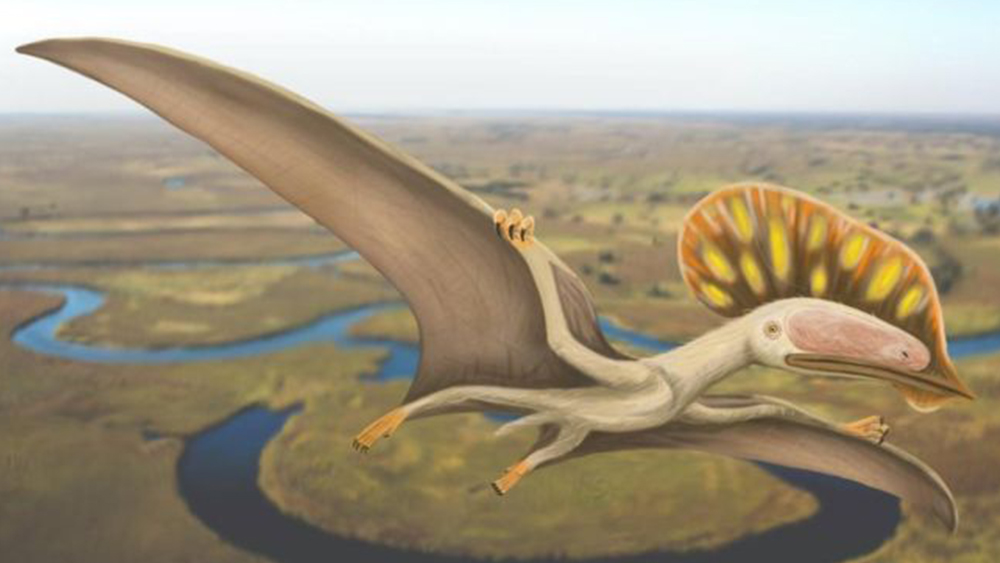The very first tapejarid pterosaur identified in the United Kingdom was recently found on the Isle of Wight along the southern coast of England.1 But the discovery also raises some questions that are uncomfortable for uniformitarian scientists.
Tapejarids are extinct flying reptiles that have “elaborate soft tissue head crests” and a few other anatomical differences from other pterosaurs.1
The discovery, described in the journal Cretaceous Research, was found on the east side of the island near the town of Sandown in rocks from the Lower Cretaceous Wessex Formation in a “plant debris bed.”1 Several dinosaurs have also been found near this same locality.1
Co-author Megan Jacobs, from the University of Portsmouth, identified the fossil as a jaw piece or premaxillary bone from a tapejarid. Prior to this discovery, these types of pterosaurs have mostly been found in younger rocks from Brazil and China.2
Jacobs added, "Complete examples from Brazil and China show that they had large head crests, with the crest sometime being twice as big as the skull. The crests were probably used in sexual display and may have been brightly coloured.”2
David Martill, lead author of the paper said, “This new species adds to the diversity of dinosaurs and other prehistoric reptiles found on the island, which is now one of the most important places for Cretaceous dinosaurs in the world.”2
But should it be a surprise that these pterosaurs are found across the globe, including Europe, Asia, and South America? Many animal groups, including dinosaurs, are found on every continent—even Antarctica.3 Discoveries of tapejarids in the UK and elsewhere should not surprise scientists.
Unfortunately, uniformitarian scientists believe all forms of life evolved. Therefore, finding similar species in distant locations creates a problem. They have to assume these creatures either randomly evolved into the exact same animals while separated or that the animals somehow traveled to other continents at the precise time of fossilization. Pterosaurs have the advantage of flight, but random acts of evolution should not produce the same species on distant land masses. And yet, this is a common occurrence in the fossil record—even for the dinosaurs.3
Creation scientists realize that the different animals were all derived from the created kinds made by God during Creation Week. Pterosaurs of all types were part of the original creation, including the tapejarids.
In addition to the global expansion of the realm of the tapejarids, this discovery also pushes their age range in the fossil record back by about 40 million years on the secular timescale.1 This also creates an issue for uniformitarian scientists. Why didn’t these animals evolve over the 40 million years they supposedly existed? Why did they stay the same? Again, this is common in the fossil record.4 Animals are found to remain the same for millions of years in the secular timeframe. But how can this stasis, as it is called, occur if all things are supposedly evolving?
Finally, the authors of the paper offer no clue to the origin of these pterosaurs. They simply list all of the tapejarid fossils found around the globe and show no ancestor for any of them.1 It’s like they suddenly appear out of nowhere in the rocks. Tapejarids show up in the fossil record in the Lower Cretaceous, fully formed, remain the same, and just as suddenly disappear.
Creation geologists know these fossils are from the global Flood. The sudden appearance of fossils of all kinds is a consequence of the order of burial in the rising floodwaters. There are no unsolvable questions or mysteries if the biblical account of the Creation and the Flood are viewed as historical events.
Stage image: Artist's rendering of a tapejarid.
Stage image credit: Megan Jacobs. Copyright © 2020. Adapted for use in accordance with federal copyright (fair use doctrine) law. Usage by ICR does not imply endorsement of copyright holders.
References
1. Martill, D. M. et al. 2020. First tapejarid pterosaur from the Wessex Formation (Wealden Group: Lower Cretaceous, Barremian) of the United Kingdom. Cretaceous Research. 113(104487).
2. BBC Staff. Isle of Wight pterosaur species fossil hailed as UK first. BBC News. Posted on bbc.com May 28, 2020, accessed June 3, 2020.
3. Clarey, T. 2015. Dinosaurs: Marvels of God’s Design. Green Forest, AR: Master Books.
*Dr. Clarey is Research Associate at the Institute for Creation Research and earned his doctorate in geology from Western Michigan University.

First Tapejarid Pterosaur Found In Great Britain
The Latest
Puzzling Fossils at an Unlikely Time
Wherever and whenever life is found, it is incredibly complex. This certainly applies to cyanobacterial photosynthetic life that supposedly were some...
CREATION PODCAST
A Theory Designed to Be...Anti-Design | The Creation Podcast:...
Science is objective. At least, that’s what we’re told. But there are inherent issues with this statement that can...
Seeing the Case for Creation in Fruit Flies
Our brain is designed to smoothly and constantly process what we see via the incredibly sensitive photoreceptors (cones and rods) of our eyes.1...
Amazing Defense Systems
Bacteria (prokaryotes) are ubiquitous. A fraction cause disease in people, animals, and plants, but the majority are the foundation for the global food...
Octopus and Fish Plan a Complex Coordinated Hunt
The octopus—an invertebrate—never fails to surprise researchers with its incredible abilities.1,2
The octopus was designed...
A ''40 million year old'' 100% European Gnat
Finding well-preserved creatures in amber1 is a landfall for creation scientists, much like the numerous discoveries of soft dinosaur tissue...
CREATION PODCAST
The Undeniable Power of Narrative | The Creation Podcast: Episode...
Science is objective. At least, that’s what we’re told. But there are inherent issues with this statement that can cause...
Paintbrush of the Creator
Who doesn’t enjoy the amazing color patterns of butterflies?1,2 Such beautiful designs and construction do not reflect blind naturalistic...
November 2024 ICR Wallpaper
"Rejoice always, pray without ceasing, in everything give thanks; for this is the will of God in Christ Jesus for you." (1 Thessalonians 5:16-18 NKJV)
ICR...















